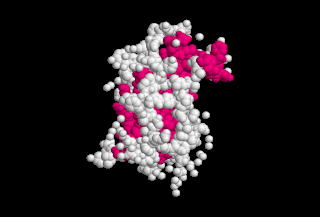
Growth hormone (GH) or somatotropin, also known as human growth hormone in its human form, is a peptide hormone that stimulates growth, cell reproduction, and cell regeneration in humans and other animals. It is thus important in human development. GH also stimulates production of IGF-1 and increases the concentration of glucose and free fatty acids. It is a type of mitogen which is specific only to the receptors on certain types of cells. GH is a 191-amino acid, single-chain polypeptide that is synthesized, stored and secreted by somatotropic cells within the lateral wings of the anterior pituitary gland.

Gigantism, also known as giantism, is a condition characterized by excessive growth and height significantly above average. In humans, this condition is caused by over-production of growth hormone in childhood, resulting in people 2.4 to 2.9 m in height.
Genentech, Inc., is an American biotechnology corporation which became a subsidiary of Roche in 2009. Genentech Research and Early Development operates as an independent center within Roche. Historically, the company is regarded as the world's first biotechnology company.

Growth hormone deficiency (GHD), or human growth hormone deficiency, is a medical condition resulting from not enough growth hormone (GH). Generally the most noticeable symptom is that an individual attains a short height. Newborns may also present low blood sugar or a small penis size. In adults there may be decreased muscle mass, high cholesterol levels, or poor bone density.
Growth hormone therapy refers to the use of growth hormone (GH) as a prescription medication—it is one form of hormone therapy. Growth hormone is a peptide hormone secreted by the pituitary gland that stimulates growth and cell reproduction. In the past, growth hormone was extracted from human pituitary glands. Growth hormone is now produced by recombinant DNA technology and is prescribed for a variety of reasons. GH therapy has been a focus of social and ethical controversies for 50 years.

Insulin-like growth factor 1 (IGF-1), also called somatomedin C, is a hormone similar in molecular structure to insulin which plays an important role in childhood growth, and has anabolic effects in adults.
Controversies regarding the use of human growth hormone (HGH) as treatment method have centered on the claims, products, and businesses related to the use of growth hormone as an anti-aging therapy. Most of these controversies fall into two categories:
- Claims of exaggerated, misleading, or unfounded assertions that growth hormone treatment safely and effectively slows or reverses the effects of aging.
- The sale of products that fraudulently or misleadingly purport to be growth hormone or to increase the user's own secretion of natural human growth hormone to a beneficial degree.
Growth hormone–releasing hormone (GHRH), also known as somatocrinin or by several other names in its endogenous forms and as somatorelin (INN) in its pharmaceutical form, is a releasing hormone of growth hormone (GH). It is a 44-amino acid peptide hormone produced in the arcuate nucleus of the hypothalamus.
The American Academy of Anti-Aging Medicine (A4M) is a United States 501(c)(3) nonprofit organization that promotes the field of anti-aging medicine, and the organization trains and certifies physicians in this specialty. As of 2011, approximately 26,000 practitioners had been given A4M certificates. The field of anti-aging medicine is not recognized by established medical organizations, such as the American Board of Medical Specialties (ABMS) and the American Medical Association (AMA). The academy's activities include lobbying and public relations. The A4M was founded in 1993 by osteopathic physicians Robert M. Goldman and Ronald Klatz, and as of 2013 claimed 26,000 members from 120 countries.

Growth hormone receptor is a protein that in humans is encoded by the GHR gene. GHR orthologs have been identified in most mammals.

Laron syndrome (LS), also known as growth hormone insensitivity or growth hormone receptor deficiency (GHRD), is an autosomal recessive disorder characterized by a lack of insulin-like growth factor 1 production in response to growth hormone. It is usually caused by inherited growth hormone receptor (GHR) mutations.

The growth-hormone-releasing hormone receptor (GHRHR) is a G-protein-coupled receptor that binds growth hormone-releasing hormone. The GHRHR activates a Gs protein that causes a cascade of cAMP via adenylate cyclase.

Growth hormone 1, also known as pituitary growth hormone or simply as growth hormone (GH) or somatotropin, is a protein that in humans is encoded by the GH1 gene.
Pegvisomant, sold under the brand name Somavert, is a growth hormone receptor antagonist used in the treatment of acromegaly. It is primarily used if the pituitary gland tumor causing the acromegaly cannot be controlled with surgery or radiation, and the use of somatostatin analogues is unsuccessful, but is also effective as a monotherapy. It is delivered as a powder that is mixed with water and injected under the skin.

Growth hormone 2 (GH2), also known more commonly as placental growth hormone (PGH) or as growth hormone variant (GH-V), is a protein that in humans is encoded by the GH2 gene. It is produced by and secreted from the placenta during pregnancy, and becomes the predominant form of growth hormone (GH) in the body during this time. Its cogener is growth hormone 1 (GH1), or pituitary growth hormone.
CJC-1295, also known as DAC:GRF, is a synthetic analogue of growth hormone-releasing hormone (GHRH) and a growth hormone secretagogue (GHS) which was developed by ConjuChem Biotechnologies. It is a modified form of GHRH (1-29) with improved pharmacokinetics, especially in regard to half-life.

Acromegaly is a disorder that results from excess growth hormone (GH) after the growth plates have closed. The initial symptom is typically enlargement of the hands and feet. There may also be an enlargement of the forehead, jaw, and nose. Other symptoms may include joint pain, thicker skin, deepening of the voice, headaches, and problems with vision. Complications of the disease may include type 2 diabetes, sleep apnea, and high blood pressure.

Sandor Earl is a former New Zealand Māori international rugby league footballer who played on the wing for the Sydney Roosters, Penrith Panthers, Canberra Raiders and the Melbourne Storm in the NRL. He was banned for four years for a doping violation in 2013.
Modified GRF (1-29) often abbreviated as mod GRF (1-29), originally known as tetrasubstitued GRF (1-29), is a term used to identify a 29 amino acid peptide analogue of growth-hormone-releasing hormone (GHRH), a releasing hormone of growth hormone (GH). It is a modified version of the shortest fully functional fragment of GHRH, often referred to as growth hormone releasing factor (1-29), and also known by its standardized name, sermorelin.
Growth hormone secretagogues or GH secretagogues (GHSs) are a class of drugs which act as secretagogues of growth hormone (GH). They include agonists of the ghrelin/growth hormone secretagogue receptor (GHSR), such as ghrelin (lenomorelin), pralmorelin (GHRP-2), GHRP-6, examorelin (hexarelin), ipamorelin, and ibutamoren (MK-677), and agonists of the growth hormone-releasing hormone receptor (GHRHR), such as growth hormone-releasing hormone, CJC-1295, sermorelin, and tesamorelin.








